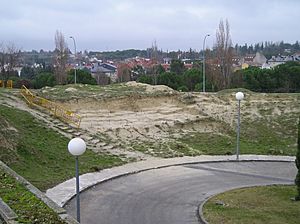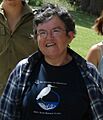Nieves López Martínez facts for kids
Quick facts for kids
Nieves López Martínez
|
|
|---|---|
 |
|
| Born | February 5, 1949 |
| Died | December 25, 2010 (aged 61) |
| Education | Complutense University of Madrid (BA/BS equivalent) University of Montpellier (MS equivalent) (PhD) |
| Scientific career | |
| Fields | Paleontology, education |
| Institutions | Autonomous University of Madrid (1978-1982) Complutense University of Madrid (since 1983) |
Nieves López Martínez (born in Burgos, Spain, on February 5, 1949 – died in Madrid, Spain, on December 15, 2010) was a Spanish paleontologist. Paleontologists are scientists who study fossils to learn about ancient life.
Nieves López Martínez was a very important scientist. She helped modernize how paleontology was studied in Spain. She focused on finding and understanding vertebrate fossils. Vertebrates are animals with backbones, like dinosaurs, mammals, and fish.
She was especially known for her work on lagomorphs. These are a group of mammals that includes pikas, rabbits, and hares. She also studied the Cretaceous–Paleogene extinction event. This was a huge event about 66 million years ago when many species, including most dinosaurs, died out. She focused on this event in the Pyrenees mountains.
Nieves López Martínez also loved teaching. She taught at universities and created special projects. One of her most famous projects was the Somosaguas Paleontology Project. This project helped students learn about fossils firsthand.
Contents
Her Education Journey
Nieves López Martínez started her university studies at the Complutense University of Madrid in Spain. In 1970, she earned her degree in Biological Sciences. This is where she first became interested in paleontology. She began studying lagomorphs with her professor, Emiliano Aguirre.
After that, she received a special scholarship. This allowed her to study for her PhD at the University of Montpellier in France. She worked with Dr. Louis Thaler from 1971 to 1973. In 1974, she finished her PhD.
She returned to Spain in 1974 and continued her research. In 1977, she earned another doctorate degree in Geology. Her university even gave her an award for her excellent work!
Her Career as a Professor
Nieves López Martínez began teaching science in 1978. She first taught at the Autonomous University of Madrid. She worked there as a professor until 1982.
Later, she returned to her old university, the Complutense University of Madrid. In 1983, she became a full professor of Paleontology. She taught classes about vertebrate fossils and Paleobiogeography. This is the study of how ancient animals and plants were spread across the Earth.
Sharing Her Discoveries
Nieves López Martínez worked hard to share paleontology with everyone. She led many workshops and shared her research with the public. She wanted more people in Spain to learn about fossils and ancient life.
She wrote many important books and papers. These became key resources for studying paleontology in Spain. Her work was especially important for understanding lagomorphs. She also started writing on science blogs in 2006. This was a new way to share science in Spain at the time.
Some of Her Books
- López Martínez, N. (Coord.) (1986). Guía de campo de los fósiles de España. This book was a guide to the fossils found in Spain.
- López Martínez, N. y Truyols Santonja, J. (1994). Paleontología. Conceptos y métodos. This book explained the basic ideas and methods of paleontology.
- López Martínez, N. (Coord.) (2009). Mesozoic terrestrial ecosystems in Eastern Spain. This book focused on ancient land environments in eastern Spain during the Mesozoic Era (the time of dinosaurs).
Her Science Blogs
Nieves López Martínez used blogs to reach more people.
- Teaching in Palaeontology of Vertebrates (Read her blog about teaching vertebrate paleontology)
- Humans and Animals (http://humanos-y-animales.blogspot.com.es/)
- GeoPaleoBiological Research in Somosaguas (http://investigacionensomosaguas.blogspot.com.es/)
The Somosaguas Paleontology Project
Nieves López Martínez led the Somosaguas Paleontology Project from 1998 to 2010. This project involved digging up and studying fossils at the Somosaguas paleontological site. What made this project special was that students did most of the research and managed the work. They worked closely with their professors.
Every spring, the project held "field seasons." During these times, students would dig for fossils and collect soil samples. They would then clean and study their finds.
Starting in 2007, the project also began teaching about geology and paleontology. They taught how to dig for fossils. This training was for researchers at first. But soon, high school students and even the public could visit. They learned about the project and saw the fossils. This was called "social paleontology." It helped more people get excited about science.
The research at Somosaguas led to many scientific papers. In the year 2000 alone, ten papers were published! Over the years, more than 30 papers have been published. The site continues to provide amazing fossil samples.
The Somosaguas Paleontological Project became a great way to learn hands-on in Spain. It also helped many new paleontologists start their research careers.
Images for kids
See also
 In Spanish: Nieves López Martínez para niños
In Spanish: Nieves López Martínez para niños






